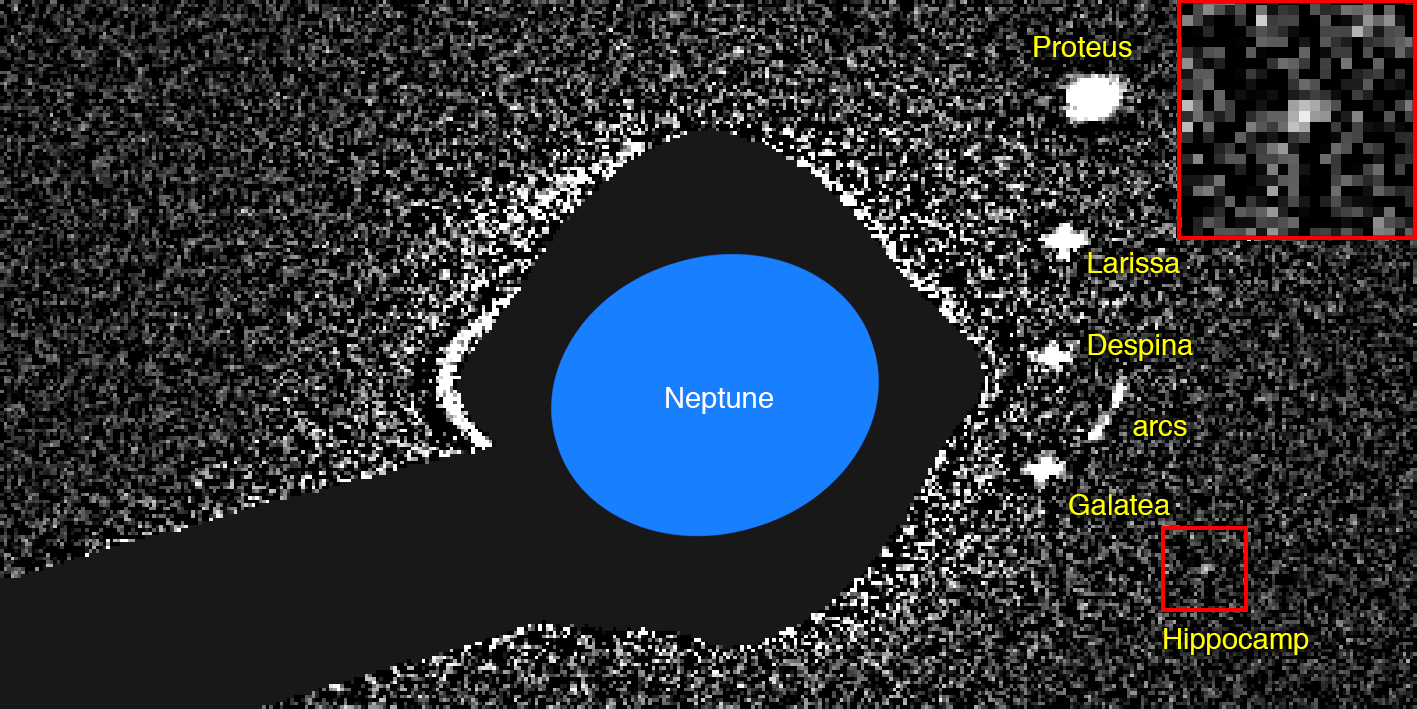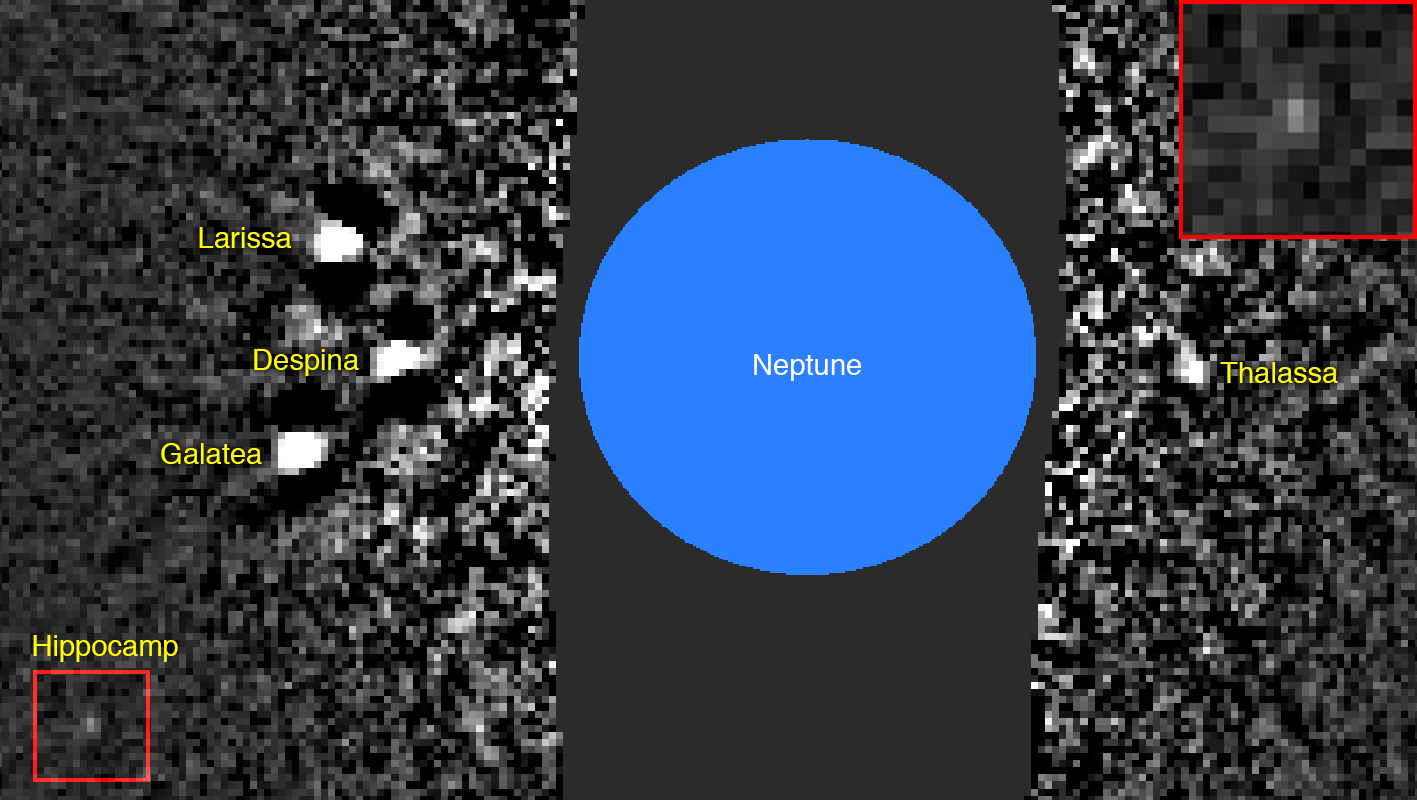Some light has been shed on a mysterious moon around Neptune.

This is the earliest image of Hippocamp, obtained by HST in 2004. Hippocamp is shown inside the red box and an enlarged version is inset at upper right. Because of the specialized image analysis required for the detection, Hippocamp was not discovered until 2013. Credit: Mark R. Showalter, SETI Institute

This is the image in which Hippocamp was discovered. It was obtained by HST in 2009, but the processing that revealed Hippocamp was not performed until 2013. The moon is visible inside the red box; an enlarged version is inset at upper right. Credit: Mark R. Showalter, SETI Institute
Astronomers call it "the moon that shouldn't be there."
After several years of analysis, a team of planetary scientists using NASA's Hubble Space Telescope has at last come up with an explanation for a mysterious moon around Neptune that they discovered with Hubble in 2013.
The tiny moon, named Hippocamp, is unusually close to a much larger Neptunian moon called Proteus. Normally, a moon like Proteus should have gravitationally swept aside or swallowed the smaller moon while clearing out its orbital path.
So why does the tiny moon exist? Hippocamp is likely a chipped-off piece of the larger moon that resulted from a collision with a comet billions of years ago. The diminutive moon, only 20 miles (about 34 kilometers) across, is 1/1000th the mass of Proteus (which is 260 miles [about 418 kilometers] across).
"The first thing we realized was that you wouldn't expect to find such a tiny moon right next to Neptune's biggest inner moon," said Mark Showalter of the SETI Institute in Mountain View, California. "In the distant past, given the slow migration outward of the larger moon, Proteus was once where Hippocamp is now."
This scenario is supported by Voyager 2 images from 1989 that show a large impact crater on Proteus, almost large enough to have shattered the moon. "In 1989, we thought the crater was the end of the story," said Showalter. "With Hubble, now we know that a little piece of Proteus got left behind and we see it today as Hippocamp." The orbits of the two moons are now 7,500 miles (about 12,070 kilometers) apart.
Neptune's satellite system has a violent and tortured history. Many billions of years ago, Neptune captured the large moon Triton from the Kuiper Belt, a large region of icy and rocky objects beyond the orbit of Neptune. Triton's gravity would have torn up Neptune's original satellite system. Triton settled into a circular orbit and the debris from shattered Neptunian moons re-coalesced into a second generation of natural satellites. However, comet bombardment continued to tear things up, leading to the birth of Hippocamp, which might be considered a third-generation satellite.
"Based on estimates of comet populations, we know that other moons in the outer solar system have been hit by comets, smashed apart, and re-accreted multiple times," noted Jack Lissauer of NASA's Ames Research Center in California's Silicon Valley, a coauthor on the new research. "This pair of satellites provides a dramatic illustration that moons are sometimes broken apart by comets."
Hippocamp is a half-horse, half-fish from Greek mythology. The scientific name for the seahorse is Hippocampus, which is also the name of an important part of the human brain. The rules of the International Astronomical Union require that the moons of Neptune are named after Greek and Roman mythology of the undersea world.
The team of astronomers in this study consists of M. Showalter (SETI Institute, Mountain View, California), I. de Pater (University of California, Berkeley, California), J. Lissauer (NASA Ames Research Center, Silicon Valley, California) and R. French (SETI Institute, Mountain View, California).
The paper will appear in the February 21 issue of the science journal Nature.
The Hubble Space Telescope is a project of international cooperation between NASA and ESA (European Space Agency). NASA's Goddard Space Flight Center in Greenbelt, Maryland, manages the telescope. The Space Telescope Science Institute (STScI) in Baltimore, Maryland, conducts Hubble science operations. STScI is operated for NASA by the Association of Universities for Research in Astronomy in Washington, D.C.
For more information about Hippocamp and Hubble, visit:
Videos
Annotated movie of Hippocamp with Proteus -
This six-frame movie shows Hippocamp just to the left of Proteus on 2016 August 31 (Visit 01, orbit 2 of GO-14217). Images are full-size. Timing is sped up by a factor of 500. The proximity of Proteus, moving in the same direction and at nearly the same speed, guides the eye and makes it easier to see the smaller moon. The disk of Neptune is shown in blue and the orbits of the two moons are drawn in yellow. A red circle identifies Hippocamp both in the full frame and in the white square enlarged and inset at lower left.
https://vimeo.com/318314541
Un-annotated movie of Hippocamp with Proteus -
This six-frame movie shows Hippocamp just to the left of Proteus on 2016 August 31 (Visit 01, orbit 2 of GO-14217). Images are full-size. Timing is sped up by a factor of 500. The proximity of Proteus, moving in the same direction and at nearly the same speed, guides the eye and makes it easier to see the smaller moon. The area inside the white box is enlarged and inset at lower left. The disk of Neptune is shown in blue.
https://vimeo.com/318314536
About the SETI Institute
Founded in 1984, the SETI Institute is a non-profit, multi-disciplinary research and education organization whose mission is to lead humanity’s quest to understand the origins and prevalence of life and intelligence in the Universe and to share that knowledge with the world. Our research encompasses the physical and biological sciences and leverages expertise in data analytics, machine learning and advanced signal detection technologies. The SETI Institute is a distinguished research partner for industry, academia and government agencies, including NASA and NSF.
Contact information
Ray Villard
Space Telescope Science Institute, Baltimore, Maryland
410-338-4514
villard@stsci.edu
Mark Showalter
SETI Institute, Mountain View, California
mshowalter@seti.org
Jack Lissauer
NASA Ames Research Center, Silicon Valley, California
jack.lissauer@nasa.gov
Rebecca McDonald
Communications Director, SETI Institute
rmcdonald@seti.org





